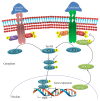The Complex Role of STAT3 in Viral Infections
- PMID: 26199948
- PMCID: PMC4496485
- DOI: 10.1155/2015/272359
The Complex Role of STAT3 in Viral Infections
Abstract
Signal transducer and activators of transcription-3 (STAT3) regulates diverse biological functions including cell growth, differentiation, and apoptosis. In addition, STAT3 plays a key role in regulating host immune and inflammatory responses and in the pathogenesis of many cancers. Several studies reported differential regulation of STAT3 in a range of viral infections. Interestingly, STAT3 appears to direct seemingly contradictory responses and both pro- and antiviral roles of STAT3 have been described. This review summarized the currently known functions of STAT3 in the regulation of viral replication and pathogenesis of viral infections. Some of the key unanswered questions and the gap in our current understanding of the role of STAT3 in viral pathogenesis are discussed.
Figures



Similar articles
-
STAT3 Regulates the Type I IFN-Mediated Antiviral Response by Interfering with the Nuclear Entry of STAT1.Int J Mol Sci. 2019 Sep 30;20(19):4870. doi: 10.3390/ijms20194870. Int J Mol Sci. 2019. PMID: 31575039 Free PMC article.
-
Cell density dependent increase of constitutive signal transducers and activators of transcription 3 activity in melanoma cells is mediated by Janus kinases.Mol Cancer Res. 2007 Dec;5(12):1331-41. doi: 10.1158/1541-7786.MCR-07-0317. Mol Cancer Res. 2007. PMID: 18171991
-
Involvement of fish signal transducer and activator of transcription 3 (STAT3) in SGIV replication and virus induced paraptosis.Fish Shellfish Immunol. 2014 Dec;41(2):308-16. doi: 10.1016/j.fsi.2014.09.011. Epub 2014 Sep 16. Fish Shellfish Immunol. 2014. PMID: 25230133
-
Viral manipulation of STAT3: Evade, exploit, and injure.PLoS Pathog. 2018 Mar 15;14(3):e1006839. doi: 10.1371/journal.ppat.1006839. eCollection 2018 Mar. PLoS Pathog. 2018. PMID: 29543893 Free PMC article. Review.
-
The myocardial JAK/STAT pathway: from protection to failure.Pharmacol Ther. 2008 Nov;120(2):172-85. doi: 10.1016/j.pharmthera.2008.08.002. Epub 2008 Aug 23. Pharmacol Ther. 2008. PMID: 18786563 Review.
Cited by
-
Extracellular Vesicles Regulated by Viruses and Antiviral Strategies.Front Cell Dev Biol. 2021 Oct 21;9:722020. doi: 10.3389/fcell.2021.722020. eCollection 2021. Front Cell Dev Biol. 2021. PMID: 34746122 Free PMC article. Review.
-
Transcriptomics in lung tissue upon respiratory syncytial virus infection reveals aging as important modulator of immune activation and matrix maintenance.Sci Rep. 2018 Nov 9;8(1):16653. doi: 10.1038/s41598-018-35180-2. Sci Rep. 2018. PMID: 30413794 Free PMC article.
-
Role of Long non Coding RNAs, NEAT1 and Lnc-DC Expression in Pediatric Immune Thrombocytopenic Purpura.Rep Biochem Mol Biol. 2023 Jan;11(4):635-643. doi: 10.52547/rbmb.11.4.635. Rep Biochem Mol Biol. 2023. PMID: 37131890 Free PMC article.
-
Phospholipid Scramblases: Role in Cancer Progression and Anticancer Therapeutics.Front Genet. 2022 Mar 29;13:875894. doi: 10.3389/fgene.2022.875894. eCollection 2022. Front Genet. 2022. PMID: 35422844 Free PMC article. Review.
-
Computationally predicted SARS-COV-2 encoded microRNAs target NFKB, JAK/STAT and TGFB signaling pathways.Gene Rep. 2021 Mar;22:101012. doi: 10.1016/j.genrep.2020.101012. Epub 2020 Dec 31. Gene Rep. 2021. PMID: 33398248 Free PMC article.
References
-
- Duncan S. A., Zhong Z., Wen Z., Darnell J. E., Jr. STAT signaling is active during early mammalian development. Developmental Dynamics. 1997;208(2):190–198. - PubMed
Publication types
MeSH terms
Substances
LinkOut - more resources
Full Text Sources
Other Literature Sources
Medical
Miscellaneous

